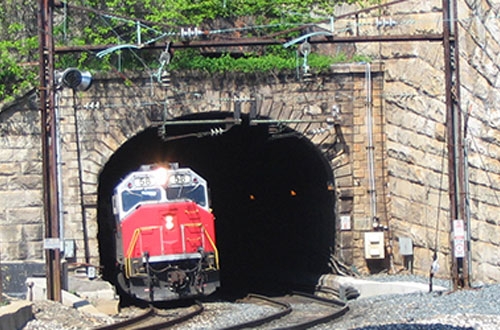FRA, MDOT, Amtrak partner to further study to improve Civil War-era tunnel
Written by Jenifer Nunez, assistant editor
Working to improve rail service, reliability and address a longstanding bottleneck along Amtrak's busy Northeast Corridor (NEC), the Federal Railroad Administration (FRA), Maryland Department of Transportation (MDOT) and Amtrak are advancing an engineering and environmental study to examine various
improvements to the 141-year-old Baltimore and Potomac (B&P) Tunnel in Baltimore, Md.
“We’re taking the first step toward upgrading rail traffic through this Civil War-era tunnel, which will improve passenger rail service along the entire East Coast,” said Maryland Gov. Martin O’Malley. “Working together to enhance transit service and reliability will increase ridership and create a sustainable, more competitive future for Maryland. I want to thank U.S. Sens. Barbara Mikulski (D-MD) and Ben Cardin (D-MD), Rep. Elijah Cummings (D-MD-07) and Maryland’s entire congressional delegation for their hard work and support for federal funding to advance this much-needed study.”
The two-track tunnel, which opened in 1873, is located between the West Baltimore MARC Station and Baltimore Penn Station and is used by Amtrak, Maryland’s MARC commuter rail trains and Norfolk Southern. The existing track geometry and outdated tunnel design significantly impedes rail movement along the busy NEC, creating a low-speed bottleneck impacting approximately 85 Amtrak trains, 57 MARC trains and one to two freight trains each day. The $60-million federally-funded study, which began last fall, is moving into a new phase with expanded public outreach and opportunities for residents and commuters to learn more about the project’s purpose and need.
“This is good news for Baltimore and the entire Northeast Corridor,” said Sen. Mikulski. “Replacing the B&P Tunnel is on the must-do list for Baltimore’s aging infrastructure. The B&P Tunnel is critical to keeping Maryland’s economy rolling, carrying all passenger and freight rail traffic on the Northeast Corridor through Baltimore. Years of operation have left it deteriorating to the point of being operationally outdated. This is an important step in the right direction for safety and the modernization of our railroad.”
The study, which will be complete in mid 2017, will include development and evaluation of various alternatives based on the need to enhance rail safety and to improve capacity, reliability and travel time for commuter, freight and intercity passenger rail service on the NEC. Alternatives will include the No Action Alternative, as well as a full array of Build Alternatives, such as rehabilitation of the existing tunnel and a new tunnel on new alignment.
The study also involves development of an Environmental Impact Statement (EIS) to comply with the National Environmental Policy Act (NEPA). The project also will be subject to Section 106 of the National Historic Preservation Act (NHPA) of 1966 and other applicable environmental laws and regulations. FRA is leading development of the EIS in close coordination with MDOT and other stakeholders.





